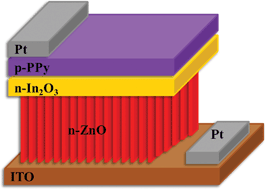Solution processed n-In2O3 nanostructures for organic–inorganic hybrid p–n junctions†
Abstract
Solution processed organic–inorganic bulk hybrid heterostructures are nowadays considered as the most promising elements to perform efficient optoelectronic functions. In this regard, In2O3 based hybrid heterostructures were fabricated using polypyrrole and their role as efficient interfacial layers was studied using polypyrrole/ZnO nanowires. The In2O3 nanostructures were synthesized through a facile wet chemical approach at an average scale of less than 10 nm in cubic phase. The presence of O and In related defects was studied through emission spectra; these were also found to exhibit their predominance in Raman measurements. The n-type characteristics and donor density value of around 1020 cm−3 were evaluated for the In2O3 specimens via Mott–Schottky plots. The role of In2O3 nanostructures as active/interfacial layers was then studied using the current–voltage characteristics obtained across the hybrid heterostructures made of polypyrrole/In2O3, polypyrrole/ZnO and polypyrrole/In2O3/ZnO. Organic–inorganic p–n diodes were obtained via in situ chemical polymerization, drop casting and hydrothermal routes. Cyclic voltammograms and Nyquist plots were used to study the reduction mechanism taking place in the nanostructures that actually results with the formation of metallic In, which plays a vital role in establishing the required conduction electrons. The same has been reasoned for the improved rectification characteristics observed across the diodes.


 Please wait while we load your content...
Please wait while we load your content...